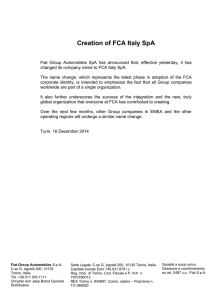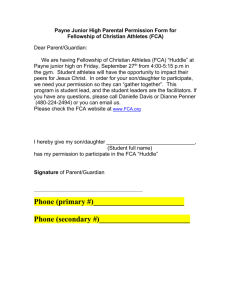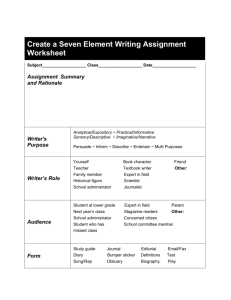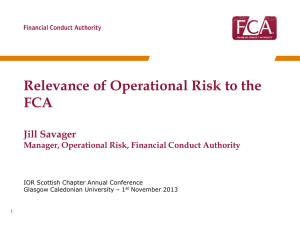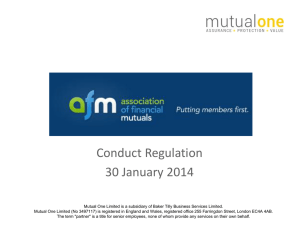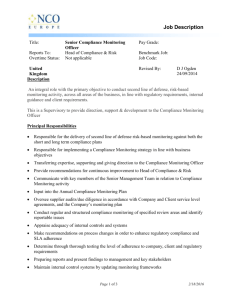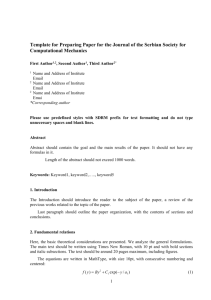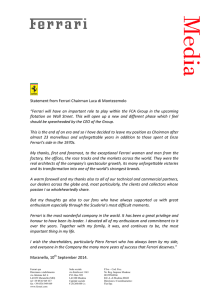• December 2015
advertisement
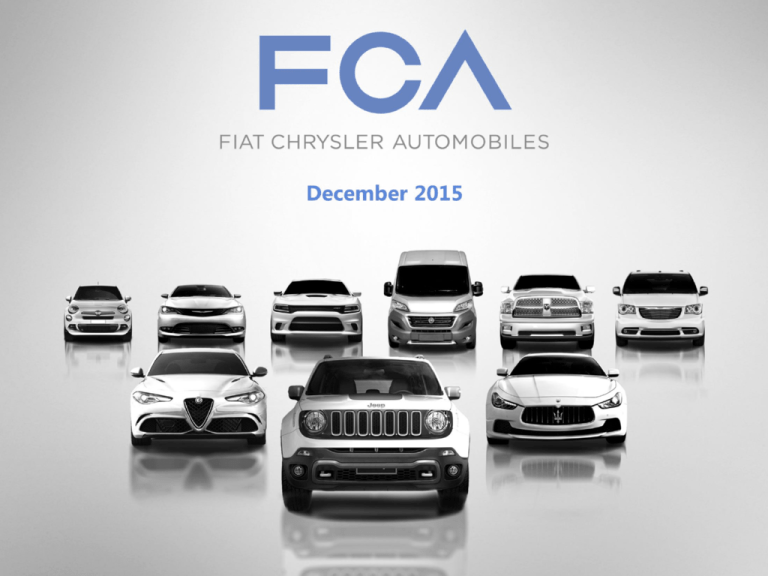
• December 2015 • Safe Harbor Statement This document contains forward-looking statements. These statements may include terms such as “may”, “will”, “expect”, “could”, “should”, “intend”, “estimate”, “anticipate”, “believe”, “remain”, “on track”, “design”, “target”, “objective”, “goal”, “forecast”, “projection”, “outlook”, “prospects”, “plan”, “intend”, or similar terms. Forward-looking statements are not guarantees of future performance. Rather, they are based on the Group’s current expectations and projections about future events and, by their nature, are subject to inherent risks and uncertainties. They relate to events and depend on circumstances that may or may not occur or exist in the future and, as such, undue reliance should not be placed on them. Actual results may differ materially from those expressed in such statements as a result of a variety of factors, including: the Group’s ability to reach certain minimum vehicle sales volumes; developments in global financial markets and general economic and other conditions; changes in demand for automotive products, which is highly cyclical; the Group’s ability to enrich the product portfolio and offer innovative products; the high level of competition in the automotive industry; the Group’s ability to expand certain of the Group’s brands internationally; changes in the Group’s credit ratings; the Group’s ability to realize anticipated benefits from any acquisitions, joint venture arrangements and other strategic alliances; the Group’s ability to integrate its operations; potential shortfalls in the Group’s defined benefit pension plans; the Group’s ability to provide or arrange for adequate access to financing for the Group’s dealers and retail customers; the Group’s ability to access funding to execute the Group’s business plan and improve the Group’s business, financial condition and results of operations; various types of claims, lawsuits and other contingent obligations against the Group; disruptions arising from political, social and economic instability; material operating capital expenditures and other effects from and in relation to environmental, health and safety regulations; developments in labor and industrial relations and developments in applicable labor laws; increases in costs, disruptions of supply or shortages of raw materials; exchange rate fluctuations, interest rate changes, credit risk and other market risks; our ability to achieve the benefits expected from the proposed separation of Ferrari; political and civil unrest; earthquakes or other disasters and other risks and uncertainties. • Any forward-looking statements contained in this document speak only as of the date of this document and the Company does not undertake any obligation to update or revise publicly forward-looking statements. Further information concerning the Group and its businesses, including factors that could materially affect the Company’s financial results, is included in the Company’s reports and filings with the U.S. Securities and Exchange Commission, the AFM and CONSOB. • • • • • • • • • • • • • Key Capital Market Actions Since May 2014 Business Plan Q1 Q2 Q3 Q4 Merger Effective and Dual-Listing (October 12-13) Merger of Fiat S.p.A with and into Fiat Investment N.V. became effective October 12 Surviving entity renamed Fiat Chrysler Automobiles N.V. (FCA) October 13, FCA listed for trading on Milan and New York (NYSE) exchanges 5-Year Business Plan (May 6) Executing premium strategy Transition away from mass market focus in Europe Jeep globalization and localization Increasing volumes globally Achieving financial objectives around growth, margin, deleveraging and liquidity • • • • • • Merger Effective and Dual-Listing (October 12-13) Merger of Fiat S.p.A with and into Fiat Investment N.V. becomes effective October 12 Surviving entity renamed Fiat Chrysler Automobiles N.V. (FCA) October 13, FCA listed for trading on New York Stock exchange (NYSE) and the MTA 5-Year Business Plan (May 6) Combined company presents detailed business plan including product plans and financial targets for 2014 - 2018 Announced Planned Transactions (October 29) Issue common shares Issue mandatory convertible security Separate Ferrari through an IPO and subsequent spin-off • • • • U.S. Unsecured Notes Offering (April 14) Issued $3.0B of USD-denominated senior unsecured notes Proceeds used for the redemption of FCA U.S.’s senior secured notes due 2019 • • • • • • Ferrari IPO (October 20) Ferrari N.V. (NYSE: RACE) successfully placed 10% of shares for $982M 2014 2015 2016 Spin-off of Ferrari (January 2016) FCA’s remaining 80% shareholding to be distributed to FCA holders of shares and MCS Unlock hidden value of Ferrari • • • • • • • Removal of FCA US Ring-fencing • • • • • • • • • • • • • May 2014 Business Plan Confirmed December 2015 No significant change to key initiatives May 2014 Business Plan financial targets confirmed Changes impacting Plan Regional industry performance Shifts in brand performance Cadence of product launches Capital market transactions Separation of Ferrari FX environment May 2014 Key Initiatives Executing premium strategy Transition away from mass market focus in Europe Jeep globalization and localization Increasing volumes globally Achieving financial objectives around growth, margin, deleveraging and liquidity • • • • • • • • • • • • • • • • • Differentiated Value Proposition Broad-based brand portfolio Accelerating financial trajectory Focused execution Unique and broad-based brand portfolio Volume growth Margin expansion Strengthening balance sheet Management track record of value enhancement $4B equity raised in Q4 2014 mitigates Business Plan execution risk ~€1.6B net industrial debt reduction from Ferrari IPO and spin-off* Debt restructuring to remove FCA US ring-fencing in H1 2016 Significant reduction in targeted liquidity after elimination of FCA US ring-fencing Target to have investment grade credit metrics by 2017 Target to have positive net industrial cash by end of 2018 Plan to close NAFTA competitive margin gap Localize Jeep production in EMEA (Italy), LATAM (Brazil), APAC (China) Continue to grow Maserati and launch Alfa Romeo worldwide Repurpose Italian manufacturing footprint to luxury and premium vehicles Mass market brand architecture reduction of 25% and parts commonization drive efficiencies Unique and broadbased brand portfolio targeting specific market segments Leverage Jeep's global appeal with increased segment coverage and geographic expansion in EMEA, APAC and LATAM Portfolio expansion into white space opportunities (i.e. small SUV, CUV’s, mid-size pickup, premium, luxury) Clear focus on APAC mainly through Jeep and Alfa Romeo brands Targeted sales of ~7M units (including JVs) in 2018, up from 4.8M units in 2014 Fiat and Chrysler turnarounds – brand, product and operational revitalization Integration of Fiat and Chrysler – leveraging synergies for global expansion Spin-off of Fiat Industrial and Ferrari* – unlocking value to shareholders Long-standing management team continuity * Expected Q1 2016 • OEM Shareholder Value Creation History Cumulative Shareholder Return Index – June 1, 2004 to December 1, 2015 • (Closing price on June 1, 2004 = 100) • Note: FCA total shareholder return reflects Fiat S.p.A. only from June 1, 2004 to Dec 31, 2010; Fiat S.p.A.+Fiat Industrial for Jan 3, 2011 to Sep 27, 2013; Fiat S.p.A.+CNHi from Sep 30, 2013 to Oct 10, 2014; and FCA+CNHi from Oct 12, 2014 to current; GM rebased to 100 at IPO (Nov 2010) • Source: FACTSET (as of December 1, 2015) Total shareholder return since June 9th, 2010 Total shareholder return since June 10, 2009 281% 108% 231% 257% 14% 288% 103% 13% (40%) 391% 123% Total shareholder return since June 1, 2004 • FCA Today Note: Numbers may not add due to rounding • 1 Represents net revenues from external customers and does not include intercompany amounts • 2 Includes cash & cash equivalents, current securities and undrawn committed credit facilities Adjusted EBIT €3.6B Memo: LATAM (3)% • Other & Unallocated (6)% Net Revenues1 €83.1B Adjusted EBIT €3.8B Net Revenues1 €96.1B Memo: EMEA (1)% • Other & Unallocated (4)% FY 2014 9 months YTD 2015 Maserati • 3% Maserati • 2% Ferrari • 3% Ferrari • 2% • Broad-Based Brand Portfolio Designates global growth opportunities Mass-market SUVs Sport cars and UVs Premium Exclusive performance Sedans & minivans Trucks & LCVs Performance LCVs Luxury Brand portfolios targeting unique market segments • Portfolio expansion into white space opportunities • (e.g. small SUV, CUV, mid-size pickup, premium, luxury) 500 family & functional • • • • • • • • • • Growth strategy Entry into largest global SUV segments with new products in new regions Global launch of all-new Renegade and C-SUV Localizing production in APAC (China), LATAM (Brazil) and EMEA (Italy) From 5 nameplates produced in 1 country to 7 nameplates produced in 6 countries on 4 continents Update FY 2015 global sales expected to be ~20% higher than record FY 2014 sales of 1.0M Localized production commenced in EMEA, LATAM and APAC Robust global performance driven by NAFTA, EMEA and LATAM Renegade well received, offers new volume opportunity globally 2014: 1,017,000 9 months YTD 2015: 914,000 2018E: ~2,000,000 Sales volume growth Grand Cherokee Patriot Compass Cherokee Wrangler Renegade Jeep • • • • • Volume Growth Evolution Sales (‘000) Jeep: UV industry: +255% (+24% CAGR) +172% (+18% CAGR) +67% (+19% CAGR) Exceptional performance since 2009, with contribution from all vehicles and all regions +135% +271% +349% +158% +286% All New ~1,100k ~200k ~500k Production +20% (+6% CAGR) Localized production and new vehicle launches support future growth 2014 2015 Discontinued Model NAFTA 59k EMEA 58k LATAM 38k APAC 2k NAFTA EMEA LATAM APAC • • • • • • • • • • • • Grow the brand with product innovations and best in class attributes Light duty 3.0L EcoDiesel engine Most capable off-road pickup truck Best fuel economy1, power, payload and towing2 Offer full portfolio of light commercial vehicles by leveraging Fiat Professional product line-up (small and large vans) Growth strategy 1 2015 Ram 1500 pickup – based on latest competitive data 2 2015 Ram 3500 pickup – based on latest competitive data Ram Update U.S. large pickup share has increased from 15.5% in 2009 to 20.6% for 9 months YTD 2015 Continued strong ATP and market share levels, despite GM and Ford pickup renewals in 2013 and 2014, respectively Sales volume growth 2014: 582,000 9 months YTD 2015: 455,000 2018E: ~600,000 1500 ProMaster ProMaster City 2500 & 3500 Chassis Cab • Quattroporte Ghibli GranTurismo • Maserati 2014: 32,800 • 9 months YTD 2015: 22,700 • 2018E: ~75,000 Sales volume growth Expanding portfolio to key luxury market segments • Ghibli – full-size sedan (2013) • Levante – luxury SUV, key growth driver for increased volumes • Increased global volumes leveraging high quality, under-utilized Italian manufacturing capacity • Growth strategy Update Weaker segment demand in the U.S. and China • Market share growth in all regions • Balancing production and natural absorption rate in the market • Levante to further drive volume growth GranCabrio • Levante (2016) • • • • • • • • • • • • • Mito Giulietta 4C 4C Spider Giulia (2016) Alfa Romeo 2014: 68,000 9 months YTD 2015: 49,000 2018E: ~400,000 Sales volume growth Return to legacy of the brand with all new RWD / AWD architecture and powertrains Expand reach into global high margin premium vehicle segments Add distribution in NAFTA and APAC Growth strategy Update Commitment to overall brand and product strategy and 2018 targets remains in place Launch cadence re-paced due to: Uncertainties in China Need to guarantee proper global distribution network execution R&D, manufacturing and product investment reduced through 2018 Planned product line-up will now be completed by mid-2020 • • • • • • • • • • 200 300 Growth strategy Mainstream NAFTA brand Clear brand definition with separation from Dodge Fully redesigned minivan in 2016 Gain share in high-volume sedan segments Increase segments covered, including CUVs Update All-new minivan – January 2016 reveal with April 2016 marketing launch Introduce world’s first hybrid minivan Gained 2 pts of share y-o-y in mid-size sedan segment (2nd largest U.S. segment) Given reduction of volumes in sedan segments, re-evaluating product portfolio 2014: 352,000 9 months YTD 2015: 278,000 2018E: ~800,000 Sales volume growth Chrysler Town & Country (Renewal 2016) • • • • • • • • • • • • • • • • Growth strategy Focus brand messaging on performance vehicles for the mainstream RWD and AWD products SRT as exclusive Dodge sub-brand for ultimate performance models Target young demographic Emphasis on uniqueness that drives margin Update Youngest demographic of any volume OEM Record Challenger sales YTD fueled by halo of successful Hellcat launch Dodge brand average per unit net margin +36% for 9 months YTD 2015 vs. 2014 2014: 753,000 9 months YTD 2015: 501,000 2018E: ~700,000 Sales volume Dodge Journey Dart Grand Caravan Viper Charger Challenger Durango • • • • • • • • • • • • • • • • • • Fiat and Fiat Professional Growth strategy 2014: 487,000 9 months YTD 2015: 330,000 2018E: ~600,000 Sales volume growth 2014: 1,377,000 9 months YTD 2015: 938,000 2018E: ~1,900,000 Product portfolio that addresses all commercial lightweight transport needs Strengthen Middle East and Africa penetration and maintain existing Europe share Leverage brand flexibility to allow for regional positioning optimization Reach upper end of small car segments in EMEA Keep economy models in select regions (e.g. LATAM) Grow LATAM share with new Strada and Toro pickups Launch derivative products for 500 family Strada Dobló Fiorino Scudo Fullback (2016) Ducato Toro (2016) Freemont Panda Qubo 500/Cabrio 500L 500X 124 Spider (2016) Punto Palio Uno Tipo • • • • • • • • • • • • • • • NAFTA Region Outlook Units (M) NAFTA & U.S. (Total vehicle sales including medium/heavy trucks) Current May ‘14 Bus Plan Heightened focus on recalls Regulatory compliance costs Cost of new UAW contract Industry volumes peaking Strong stable industry Well-positioned to take advantage of SUV and pickup growth Introduce Alfa Romeo brand Legacy products replaced Margin improvement plan Improved pricing and mix Lower R&D after 2016 Reduce manufacturing costs Q3 2015 Adjusted EBIT margin of 6.7% Adjusted EBIT Margin Source: IHS Adjusted EBIT margins currently at Business Plan levels forecasted for 2018 Target to further close margin gap to competitors Unit Sales 2.5M 1.9M • • • NAFTA Regional Update Net Pricing Mix Service & Parts • • Warranty Industrial Costs Product Costs Adjusted EBIT margin (Q4 run rate: ~7%) Industry New Products [white space and refreshes] Recall Campaign Related Costs UAW Contract Changes in regulatory environment have caused FCA to re-assess processes and reserve adequacy Charge taken in Q3 2015 (€761M; excluded from Adjusted EBIT) for vehicles sold in prior periods, and higher accrual rates for new shipments Increased costs for the industry will likely trigger pricing actions by OEMs to maintain profitability New agreement signed in October which spans 4 years with wage increases for all eligible U.S. represented employees Eliminates unsustainable “Two Tier” wage structure via a multi-year wage progression plan Modified profit sharing formula tied to NAFTA Adjusted EBIT margin Fixed cost increase ~€340M for 2016 Margin Improvement Plan • • • • • • • • • • • • • • • • • • LATAM Region Outlook LATAM & Brazil (Light vehicle sales) LATAM Current May ‘14 Bus Plan Units (M) Market leader with extensive local production and distribution Significant cost advantages with flexible production sites and Pernambuco plant upside Localized Jeep production Expand product offerings to larger higher margin vehicles while maintaining leadership in small vehicle segments Market volumes continue to decline Market and political uncertainty Continued inflationary pressures More competitors localized Currency devaluation pressures Source: IHS While industry challenges worse than expected, FCA is best positioned OEM given market leadership, cost advantages and upside from Pernambuco plant Adjusted EBIT Margin Unit Sales 0.8M 0.4M • • • • • • • • • • • Pernambuco – FCA’s Most Advanced Plant Capacity of >250k vehicles per annum Ability to produce three different vehicles, starting with the Jeep Renegade and Fiat Toro Entry into fast-growing Brazilian SUV market SUV market expected to double by 2018 Attractive financing structure €1.3B investment 80% subsidized by National Development Bank Significant tax incentives Integrated supplier park Production started Q1 2015 - 100% utilization expected in late 2016 FY 2015 Production: Renegade ~52k; Toro ~3k Rio Betim Sao Paulo Pernambuco • • • • • • • • • • APAC Region Outlook APAC & China (Light vehicle sales) China APAC Current May ‘14 Bus Plan Units (M) Source: IHS Expansion of selected global brands with strong brand equity and pricing power (focus on Jeep and Alfa Romeo) Localize Jeep manufacturing in growing UV market through JV Expand distribution network Focus on SUV’s – fastest growing segment in the region Economic volatility in some markets Weaker industry growth Price pressure in premium segments and from local brands in mass market segments Period of transition from importer to local producer for Cherokee, Renegade and C-SUV Localization of Jeep products in China expected to be completed in 2016 allowing brand to capitalize on expected strong growth in SUV segments Unit Sales 0.3M 0.2M Adjusted EBIT Margin • • • • • • • • • • • • • • • • • • China Localized Production Plan China Joint Ventures 2014 2018 GAC Fiat JV – Changsha Assembly – 1 platform 2 models Engine – 1 engine GAC Fiat JV – Changsha Assembly – 1 platform 5 models Engine – 5 engines GAC Fiat JV – Guangzhou Assembly – 1 platform 3 models Vehicle Capacity 775k Vehicle Capacity 195k Guangzhou Automobile Group Co., Ltd. Expand product portfolio in China Local production of Jeep, Fiat, and Chrysler branded products utilizing established JV relationships Alfa Romeo brand to enter premium segment via imports UV segments are the fastest growing segments in China Grow distribution network Localized production eliminates high import duties • • • • • • • • • • EMEA Region Outlook EMEA & EU28+EFTA (Light vehicle sales) EU28+EFTA EMEA Current May ‘14 Bus Plan Units (M) Source: IHS EU recovery ahead of expectations New Jeep models and Alfa Romeo launch Expansion into largest growing small SUV segment Continue Fiat 500 family focus. . . not chasing share in commodity segments Repurpose capacity to support global luxury and premium strategy Continued pricing pressures High fleet mix Overcapacity in region Impact of future emissions compliance (dieselgate) Recovery in region ahead of plan with some future uncertainty related to industry implications from recent emissions compliance issues Adjusted EBIT Margin Unit Sales 1.2M 1.0M • Manufacturing Footprint in Italy • Repurposed For Export Opportunity Modena AGAP (Grugliasco) Mirafiori Cassino G. Vico (Pomigliano) Melfi Atessa (Sevel) * # of models • ** Capacity utilization based on Harbour definition (units produced / line rate x 16 hours x 235 days) • Note: Excludes Ferrari plant 100%+ 57% Memo: Harbour Q3 2015 Utilization = 89% Capacity Utilization • • • • • • • • • • • • • • • • • • • • Regional Regulatory Compliance Plan – GHG Globally Optimized CO2 Compliance Plan Measures CO2 Based on engine size Separate import and export fleets Measures fuel economy and CO2 Footprint based Car / truck fleets Zero emission req. Measures CO2 Vehicle weight based Car and light commercial fleets Measures CO2 Vehicle weight based One fleet Low rolling resistance tires Mild electrification (stop/start) Light-weighting Aero improvements Down-sized turbo engines Volumes Mix Rates Renewal Scope Powertrains Products Program Timing Hybrid Electric Vehicles (HEV) Plug-in Hybrid Electric Vehicles (PHEV) Battery Electric Vehicles (BEV) Each region has a unique set of regulatory requirements All regions use a common set of portfolio assumptions Prioritize vehicle efficiency improvements and conventional powertrain technologies Apply battery / electric technologies, as needed, for fleet compliance: Plans in place to be compliant through at least 2019 • • Capex spending increases to peak in 2017 to support heavy cadence of new / refreshed product programs • R&D spending increases slightly over period, peaking in 2017 • Spending as a percentage of revenues in-line with industry average at end of plan period • Flexibility to reduce or reschedule capex and R&D spending if industry outlook deteriorates €B Capex and R&D Spending Plan Industry Outlook vs. Plan As planned Lower Minimum to sustain operations Capex and R&D range ~10% Capex and R&D % Revenues ~8% Note: Includes capitalized R&D • • • • • • • • • Liquidity and Debt Update Liquidity Dec. 31 €B €B Bank + other debt Capital Market Note: Capital Market includes the voluntary redemption of FCA US 2021 Notes for $3.1B in Q4’15; other debt includes Canadian Healthcare Trust Notes. Figures may not add due to rounding €15-20B* Net Industrial (Debt) Cash * Post elimination of FCA US ring-fencing ** May 2014 Plan Debt Maturity Profile As of September 30, 2015 (Face Values) (0.5-1.0)** Note: 2015E reflects transactions completed in connection with the Ferrari IPO; does not include impact of Ferrari spin-off of ~€0.7B (6.6-7.1) Note: 2015E reflects Ferrari IPO, redemption of FCA US 2021 Notes and cancellation of FCA US Revolving Credit Facility; does not include Ferrari separation effects of ~€1.5B YE 2015 Net Industrial Debt expected to be more than €3B lower than Business Plan – includes €0.9B from Ferrari IPO Ferrari spin-off will reduce Net Industrial Debt by an additional ~€0.7B Redemption of FCA US 2021 Notes and termination of $1.3B Revolving Credit Facility – critical step toward the elimination of ring-fencing and a more efficient capital structure Manageable maturity profile Net Industrial Cash position by 2018 Finance charges reduced from €2.0B in 2014 to ~€1.3B in 2018 (9.8-10.3)** >2.0 • Financial Plan Targets Net Revenues Adjusted EBIT • Margin % Capex Net Industrial (Debt) Cash 2014A €96B €3.8B • 3.9% Adjusted Net Profit • Adjusted Basic EPS €1.1B • EPS €0.81 €8.1B €(7.7)B * Reflects transactions completed in connection with the Ferrari IPO • ** Adjusted for 2014 Capital Market transactions (MCS + €1.9B, FCA treasury shares + €0.8B, FCA Cash Exit Rights €0.4B), and Ferrari IPO (+€0.9B) and spin-off (~+€0.7B) as well as expected reduction of positive cash flows from Ferrari post spin-off • Proven Management Team Group Executive Council • Summary May 2014 Business Plan key initiatives remain intact • Changes in external factors have positively and negatively impacted plan deliverables • Actions taken by the Group to adjust to market conditions and de-risk plan execution • Planned separation of Ferrari will unlock value for shareholders and strengthen FCA’s balance sheet • May 2014 Business Plan financial targets confirmed • • • FCA monitors its operations through the use of various supplemental financial measures that may not be comparable to other similarly titled measures of other companies. Accordingly, investors and analysts should exercise appropriate caution in comparing these supplemental financial measures to similarly titled financial measures reported by other companies. Group management believes these supplemental financial measures provide comparable measures of its financial performance which then facilitate management’s ability to identify operational trends, as well as make decisions regarding future spending, resource allocations and other operational decisions. Supplemental Financial Measures FCA’s supplemental financial measures are defined as follows1: Adjusted Earnings Before Interest and Taxes (“Adjusted EBIT”) is computed starting from EBIT and then adjusting to exclude gains and losses on the disposals of investments, restructuring, impairments, asset write-offs and other unusual items that are considered rare or discrete events that are infrequent in nature. These same items, on a tax effected basis, are factored into the calculation of Adjusted Net Profit and Adjusted EPS Net Industrial Debt is computed as debt plus other financial liabilities related to Industrial Activities less (i) cash and cash equivalents, (ii) current securities, (iii) current financial receivables from Group or jointly controlled financial services entities and (iv) other financial assets. Therefore, debt, cash and other financial assets/liabilities pertaining to Financial Services entities are excluded from the computation of Net Industrial Debt 1 Refer to the presentation of FCA Q3 2015 Results and 2014 Full Year Results for a reconciliation of FCA’s supplemental financial measures to their most directly comparable IFRS measures. •
